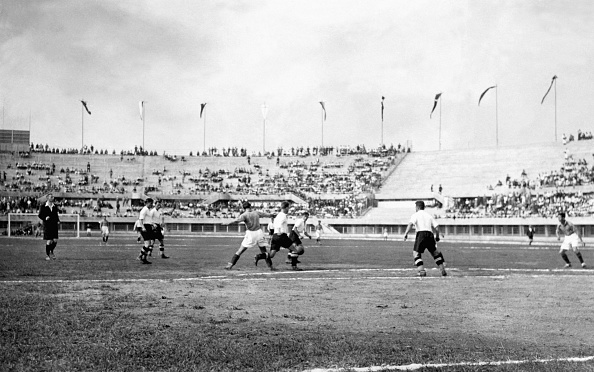The history of the FIFA World Cup would be different if the tiebreakers of today were always implemented. Not only would we see some different knockout stage ties, but it’s perfectly possible that entirely different countries would’ve won certain World Cups.
How Tiebreakers Affected the History of the FIFA World Cup
The moment France became world champions. Goosebumps 🥺 🇫🇷 @paulpogba | @equipedefrance
— FIFA World Cup (@FIFAWorldCup) July 27, 2022
Types of Tiebreakers Through History
In football, tiebreakers are used to separate two or more teams who are even on points, to determine who advances from a group or a knockout stage match. The tiebreakers differ depending on which stage of a tournament it is. For example, nowadays the FIFA World Cup uses overall goal difference to split teams even on points in a group, whereas extra time and possibly a penalty shootout separate teams in a knockout stage match.
It’s also worth noting that tiebreakers can differ depending on what competition it is. As previously mentioned, the World Cup uses overall goal difference whereas UEFA tournaments, like the European Championship, prioritize head-to-head-result.
Tiebreakers don’t only vary from tournament to tournament, they’ve also evolved throughout history. Previously, goal ratio could be used to determine what team would advance to the knockout stage of a World Cup when tied on points in a group. This practice was discontinued after England conceded zero goals at the 1966 tournament, making the concept completely inapplicable.
Also, sometimes the World Cup has used play-offs to split teams tied on points. Wales notably defeated Hungary in such a match to reach the quarter-finals of the 1958 World Cup. Additionally, knockout stage matches weren’t always decided by penalties, but by replays.
However, what if the tiebreakers of today had always been in use at the World Cup? How would it affect the history of the competition? That will be examined in this article. More specifically, World Cup tiebreakers and not head-to-head results which as previously mentioned are used at the European Championship. The World Cups will be examined in chronological order.
Read more: 26-Player Match Day Squad Approved by FIFA for Qatar World Cup
Minor Differences at the 1934 and 1938 World Cups
At the 1934 World Cup, the quarter-final match between Italy and Spain would’ve gone to penalties instead of being won by the Azzurri in a replay. Spain could’ve won in the shootout, meaning either they, Austria or Czechoslovakia would’ve won the World Cup because of the bracket. Still, it’s unlikely given how corrupt the tournament arguably was.
At the 1938 World Cup, the round of 16 matches between Switzerland and Germany, and Cuba and Romania would be decided by penalties instead of resulting in replays won by Switzerland and Cuba respectively. Still, even if the shootouts resulted in different winners than in our timeline, they would’ve likely been eliminated in the quarter-finals against Hungary and Sweden respectively.
Moreover, the quarter-final match between Brazil and Czechoslovakia would also go to penalties. Had Czechoslovakia won, they would’ve probably lost against Italy in the semi-finals.
Read more: World Cup 2022: Teams That Could Cause An Upset
A New World Champion in 1954
The 1954 World Cup is by far the one where the use of modern-day tiebreakers would have the biggest effect. Turkey would’ve advanced from Group 2 to the last eight ahead of eventual champions West Germany. However, it’s worth noting that this World Cup was really odd since teams only played two matches in the group stage instead of a full round-robin.
If West Germany also played against South Korea, they may very well have gotten a goal difference good enough to advance with according to the tiebreakers of today. Not to mention that Turkey would’ve had their decent goal difference obliterated by the Mighty Magyars. Nevertheless, idiotic or not, it was the format used.
In the final eight, Turkey would’ve most likely lost against Yugoslavia. Furthermore, Italy would’ve advanced to the quarter-finals from Group 4 instead of Switzerland, who the Italians defeated in a play-off. This would set up a quarter-final tie against Austria.
It would be a close affair, though an edge has to be given to the Austrians who simply were a bit better back then. They would notably get revenge for their 1934 exit. Because of the bracketology, this means that either Yugoslavia, Austria or Hungary would’ve won that World Cup. Probably the Mighty Magyars, but anything could’ve happened.
⚽️ 27 goals in one World Cup 🤯
⚽️ An average of 5.4 per match 🤯🇭🇺 Hungary tore up the #WorldCup record books in 1954 with their groundbreaking style and dazzling attack of Hidegkuti, Kocsis & Puskas 🤩 pic.twitter.com/0NJ9ytgmFh
— FIFA World Cup (@FIFAWorldCup) June 4, 2020
1958 FIFA World Cup
The 1958 World Cup is the last one where the use of modern-day tiebreakers would have an impact. Czechoslovakia would’ve advanced to the last eight over Northern Ireland, and Hungary would’ve advanced over Wales. This wouldn’t really affect that much, though. The semi-final teams would most likely remain the same as in our timeline, as the two would probably lose against Brazil and France respectively.
Read more: Four Teams With the Best Chance to Become First-Time World Cup Winners
Main Photo






